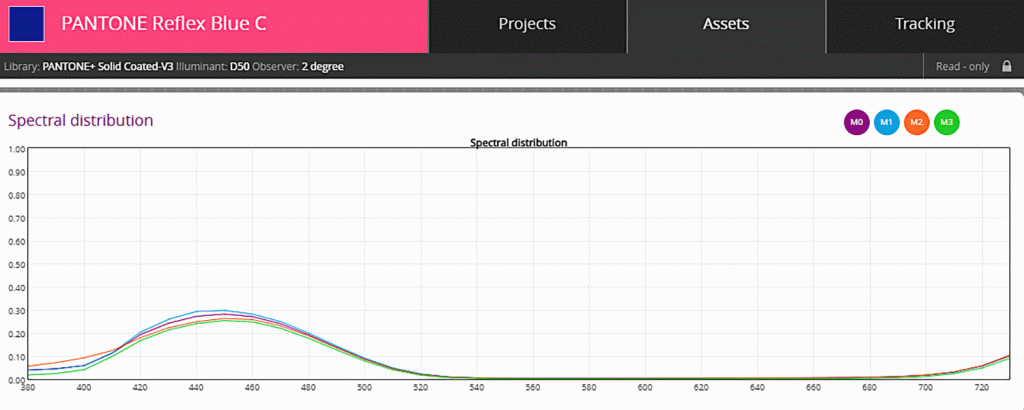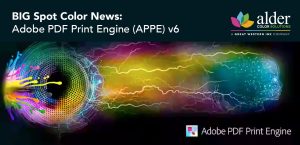Understanding Measurement Modes
M0, M1, M2, and M3 in Spectrophotometry for Printed Materials
by Bill Owen – Alder Color Solutions
When measuring color data from printed materials using a spectrophotometer, choosing the right measurement mode is crucial for achieving accurate and meaningful results. Spectrophotometers often
come equipped with several measurement modes, typically designated as M0, M1, M2, and M3. Each mode serves a specific purpose and is optimized for different types of color measurements with different inks, substrates and finishes in mind. This blog will help you understand when to use each mode for your color measurement needs.
Overview of Measurement Modes
- M0 (Spectral Data Included): This mode captures both the reflected light from the printed material and the specular reflection (the light that reflects at the same angle as the incident light). It is ideal for materials with glossy or shiny finishes.
M0 meaning: M0 refers to a measurement mode on a spectrophotometer that uses a standard illuminant A, which does not include a significant UV component.
M0 for substrates with no brightening agents: Best used with substrates that have no Optical Brightening Agents (OBA’s) and conventional non-UV ink. Since substrates without OBAs don’t fluoresce under UV light, using M0 accurately captures their color without interference from fluorescence. - M1 (Spectral Data Excluded, Observing Condition): In this mode, the specular reflection is excluded, making it suitable for matte finishes and non-reflective surfaces. M1 measures the diffuse reflectance and simulates how human eyes perceive color under standard lighting conditions. M1 is the required measurement mode for G7 GRACoL 2013. M1 is also the best choice for measuring substrates with Optical Brightening Agents (OBA’s). This mode is specifically designed to account for the fluorescence caused by OBAs by including UV light in the measurement process, providing a more accurate representation of how the color will appear under standard viewing conditions.
M1 for substrates containing OBA’s: M1 is based on D50, a theoretical light source that mimics “warm daylight”. It also accounts for the UV absorption and visible blue light reflection of optical brighteners (OBAs) in paper. Media with significant OBA content are best measured with newer M1 devices, especially if they will be viewed in newer, full-UV D50 viewing booths. - M2 (Spectral Data Excluded, Standard Observer): Similar to M1, M2 also excludes the specular reflection but aligns with the CIE 1976 (L*, a*, b*) color space, offering a more standardized approach for color data analysis. It’s beneficial for assessing color differences and consistency.
M2 for measuring UV inks: M2 measurement mode is considered best for UV inks because it eliminates the influence of ultraviolet light, effectively removing the impact of fluorescence from optical brightening agents (OBAs) often present in paper substrates, which can distort color readings when measuring UV inks that might fluoresce under UV light; essentially, M2 ensures a more accurate color measurement by simulating a viewing environment with no UV content, like a museum setting. - M3 (Polarized Light): This mode employs polarized light and is useful for measuring materials that may have optical anisotropy, such as certain textiles or plastics. M3 is ideal for applications where precise control over light interactions with the surface is necessary.
M3 “Measurement with polarization filter”: Best for measuring transparent or super shiny substrates or materials with a lot of bumpy structure. M3 uses a spectral absorption degree (with RGB filters) or spectral luminance factor (with spectral scanning head) with polarization filter pair (in radiated and in reflected light, crossing each other) under a light source that simulates any standard illuminant (gas lamp or LEDs, from 420 to at least 700 nm).
M3 for measuring textiles, films, backlit/transparent, or plastics.
When to Use Each Measurement Mode
M0: Spectral Data Included
Best for: Glossy or shiny printed materials, such as brochures or promotional items.
- Use Cases: When measuring materials that have a high gloss level, M0 captures the overall color impression, including highlights and shiny reflections. This is particularly important for products that rely on visual appeal and need to be assessed under various lighting conditions.
M1: Spectral Data Excluded, Observing Condition
Best for: Matte finishes and non-reflective surfaces.
- Use Cases: M1 is the go-to mode for printing materials like magazines or business cards where a matte finish is desired. It simulates the way colors appear to the naked eye, making it ideal for quality control and color matching during production. M1 is also the required measurement mode for submitting G7 Data to Idealliance for the GRACoL 2013 Print Specification.
M2: Spectral Data Excluded, Standard Observer
Best for: Consistency and standardization across different surfaces.
- Use Cases: Use M2 when you need to ensure that colors remain consistent across different print runs or materials. This mode aligns with the CIE color space, making it a strong choice for industries where color fidelity is critical, such as packaging or branding. M2 should also be used when measuring UV inks.
M3: Polarized Light
Best for: Anisotropic materials or specialized applications.
- Use Cases: For textiles, films, backlit/transparent, or plastics that may exhibit different colors depending on the angle of light, M3 provides precise measurements by controlling the polarization of light. This mode is particularly valuable in research and development settings where material properties are being studied. It works by reducing the amount of light coming from the measurement device by 90% which reduces reflection and metamorism.
- Measurement Illumination Condition M3: M3 defines the effect of polarization. In essence, M3 requires the UV-restricted properties of M2 and adds a definition of polarization. Polarization is used in certain measuring instruments to remove or minimize reflections. Polarization is usually accomplished by choosing a polarization function or adding an optional manufacturer-specific polarizing filter.
Applications and use of M0, M1, M2, and M3
In theory, the cases where each of these measurement illumination conditions are used are relatively clear:
- M0 is for any use where neither substrate nor imaging colorants fluoresce.
- M1, part 1, is intended for use when either substrate or imaging colorants, or both may fluoresce.
- M1, part 2, is designed for use when a substrate may fluoresce, the fluorescing characteristic needs to be captured, and the user is confident that the imaging colorants do not fluoresce. (When in doubt, consulting with the ink manufacturer is recommended.)
- M2 is for use when the paper fluoresces, but there is a desire to eliminate this effect from affecting the data.
- M3 is for special use cases where first surface reflections should be minimized, including the use of polarization to do so.

The graphic above shows the Pantone Color REFLEX BLUE measured in all four measurement modes. Note the difference in spectral curves.
Conclusion: Selecting the appropriate measurement mode (M0, M1, M2, or M3) when using a spectrophotometer for printed materials is essential for obtaining accurate color data. Understanding the characteristics of each mode and the specific applications they are suited for will enhance your ability to analyze and maintain color quality effectively. Whether you’re in quality control, design, or production, using the correct measurement mode will help ensure that your printed materials look their best, meeting both aesthetic and industry standards.
Side Note: It’s also important to consider your viewing conditions and whether or not the UV Light Spectrum is present. UV Light will “activate” OBA’s. When compared to substrates with no OBA’s, you could experience a noticeable difference in color.




